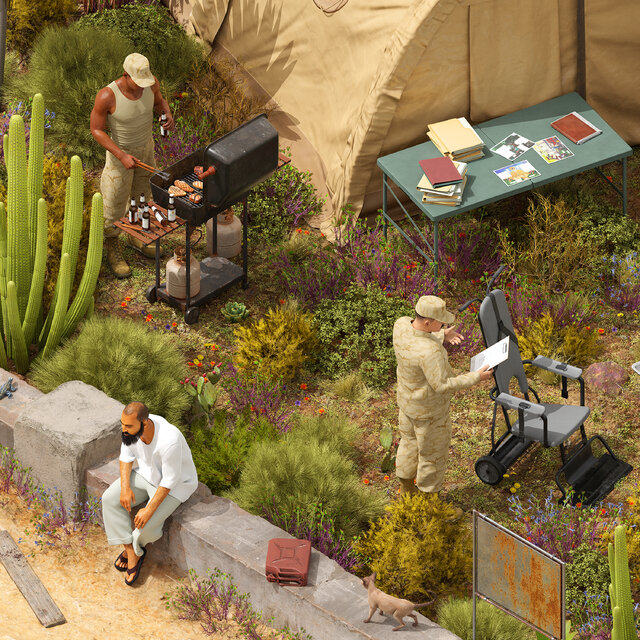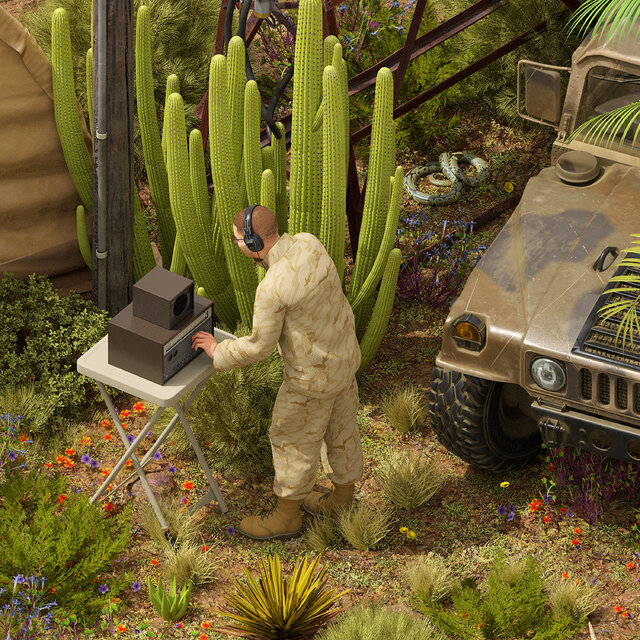Serial Productions
Serial Season 4
Guantánamo
“Serial” returns with a history of Guantánamo told by people who lived through key moments in Guantánamo’s evolution, who know things the rest of us don’t about what it’s like to be caught inside an improvised justice system.
Published March 21, 2024
Listen to and follow Serial Season 4
-
Trailer 
Listen to the trailer for Serial Season 4: Guantánamo.
Listen to the trailer for Serial Season 4: Guantánamo
Trailer — Listen to the trailer for Serial Season 4: Guantánamo
Serial Season 4: Guantánamo. One prison camp, told week by week. -
Episode 1 
“So, it felt very like college-like… Without it being… Obviously the next day wasn’t classes, it was Gitmo… ”
Poor Baby Raul
Episode 1 — Poor Baby Raul
Maybe you have an idea in your head about what it was like to work at Guantánamo, one of the most notorious prisons in the world. Think again. -
Episode 2 
“I wanted to create a persona, a thing that was not human.”
The Special Project
Episode 2 — The Special Project
In 2002, an elite interrogation team secretly staged Guantánamo’s most elaborate intel operation — to try to get a single detainee to talk. -
Episode 3 
“Am I one of them? I mean, is he innocent? I don’t know!”
Ahmad the Iguana Feeder
Episode 3 — Ahmad the Iguana Feeder
An Arabic-speaking airman is sent to Guantánamo to translate, and soon finds himself at the center of a major scandal. Part 1: Suspicion swallows evidence. -
Episode 4 
“What are we missing? Because we’re not hearing what we think we should be hearing.”
The Honeymooners
Episode 4 — The Honeymooners
The case against a young airman gets even weirder when the government pulls in two fresh investigators. Part 2: A bride, an FBI agent, and a polygraph machine. -
Episode 5 
“It’s not like we were blowing them off, we were trying to cooperate with them.”
The Big Chicken, Part 1
Episode 5 — The Big Chicken, Part 1
A new warden comes to Guantánamo and decides to make some changes. A prison’s a prison, he thinks. How hard could this be? -
Episode 6 
“This is something that they would never have made public, but, the day of the riot, morale was never higher.”
Part 2, Asymmetry
Episode 6 — Part 2, Asymmetry
After the worst happens at Guantánamo, the warden tries to explain it to the outside world – and to himself. -
Episode 7 
“Why are we afraid of this woman from the New York Times?”
The Forever Reporter
Episode 7 — The Forever Reporter
One reporter has been covering Guantánamo since the day the prison opened. The military would like her to go home now. -
Episode 8 
“This could be a ticket out of here.”
Two Ledgers
Episode 8 — Two Ledgers
Majid Khan spent years locked away in CIA black sites. What would he tell the world when he finally got the chance to speak? -
Episode 9 
“It just feels like, Jesus, he was murdered. Somebody be responsible for that.”
This Is the Weirdness
Episode 9 — This Is the Weirdness
The criminal case against the men accused of planning the Sept. 11 attacks is the one aspect of Guantánamo that would seem to make sense – until you start watching it.
About Serial Season 4
Right after Sept. 11, the United States created a brand-new criminal justice system at Guantánamo Bay. It was a prison and a court designed to deal with the people we had captured whom we suspected of being members of the Taliban or al Qaeda.
But to do what we wanted to do at Guantánamo — to interrogate detainees the way we wanted, to hold them indefinitely without charging them with a crime — we had to push aside the old, time-tested rules for detaining prisoners of war. And the consequences of that fell on ordinary people: thousands of military personnel, hundreds of prisoners, everybody scrambling through the same experiment.
There has been great journalism about the legal maneuvering to justify Guantánamo, and about the detainee abuse and the politics and policy. But “Serial” reporters Sarah Koenig and Dana Chivvis were after the inside stories, a picture of Guantánamo you could get only from the people who went through it. For years, though, all the best stories they heard about Guantánamo were off the record. But they stuck with it, figuring maybe once enough people were back in civilian life they’d be willing to tell those stories on the record. A couple of years ago, the “Serial” team started contacting people again: guards, interrogators, commanders, lawyers, chaplains, translators and former prisoners. More than a hundred people. And a remarkable number of them said: Okay, I’m ready. Here’s what happened.
“Serial” Season 4 is a history of Guantánamo told by people who lived through key moments in its evolution, who know things the rest of us don’t about what it’s like to be caught inside an improvised justice system.
 Sarah Koenig is the host and co-creator of the “Serial” podcast. The first story she produced about Guantánamo, “Habeas Schmabeas,” aired on “This American Life” in 2006. (Photograph by Sandy Honig)
Sarah Koenig is the host and co-creator of the “Serial” podcast. The first story she produced about Guantánamo, “Habeas Schmabeas,” aired on “This American Life” in 2006. (Photograph by Sandy Honig)  Dana Chivvis is the co-host of “Serial” Season 4. She’s also a producer at “Serial” and “This American Life,” where she has reported on everything from monkey selfies to the military. (Photograph by Nico Schinco)
Dana Chivvis is the co-host of “Serial” Season 4. She’s also a producer at “Serial” and “This American Life,” where she has reported on everything from monkey selfies to the military. (Photograph by Nico Schinco) - Sofia degli Alessandri is an Italian composer based in London. Her music combines field recordings, synths, chamber instruments and electronic beats. She composes for film, television, dance and other media.
- Hosts
- Sarah Koenig and Dana Chivvis
- Producer
- Jessica Weisberg
- Editor
- Julie Snyder
- Additional Reporting
- Cora Currier
- Fact Checking and Research
- Ben Phelan
- Additional Fact Checking
- Jessica Suriano and Kelsey Kudak
- Music supervision, sound design, and mixing
- Phoebe Wang
- Original score
- Sofia degli Alessandri
- Additional Editing
- David Kestenbaum, Jen Guerra, Alvin Melathe, Ellen Weiss and Ira Glass
- Contributing Editors
- Rozina Ali and Carol Rosenberg
- Assistant Producer
- Emma Grillo
- Translators and Interpreters
- Muhammad Raza Sayibzada, Nael Hijjo, Atiq Rahin, Dana El-Issa, Bachar Alhalabi, Mohammad Wali Ferdous, and Omama Othman
- Art Direction
- Pablo Delcan
- Art
- Max Guther
- Standards Editors
- Susan Wessling and Aisha Khan
- Legal Review
- Al-Amyn Sumar and Maya Gandhi
- Reporting and Research
- Amir Khafagy and Sami Yousafazai
- Additional Production
- Daniel Guillemette and Katie Mingle
- Executive Assistant
- Mack Miller
- Supervising Producer
- Ndeye Thioubou
- Deputy Managing Editor
- Sam Dolnick
- At the New York Times, thanks to
- Elizabeth Davis-Moorer, Nina Lassam, Susan Beachy, Kitty Bennett, Alain Delaquérière, Sheelagh McNeill, Kirsten Noyes, Jack Begg, Jeffrey Miranda, Colleen Wormsley, Peter Rentz, John-Michael Murphy, Jordan Cohen, Zoe Murphy, Pierre-Antoine Louis, Mahima Chablani, Kelly Doe, Anisha Muni, Kimmy Tsai, Victoria Kim, Ashka Gami, Brad Fisher, Maddy Masiello, Daniel Powell, Marion Lozano, Corey Schreppel, Isabella Anderson, and Tug Wilson
- Special thanks
- Katie Mingle, Jenelle Pifer, Alissa Shipp, Nadia Reiman, Anita Badejo, Katie Fuchs, Alison Beckman at the Center for Victims of Torture, Clive Stafford Smith, Alisa Dogramadzieva, Shuaib Almosawa, Mohamed Elfaki, Freshta Taeb, Edgar August, Esther Whitfield, Lauren Myerscough-Mueller, Mark Fallon, Pardiss Kebriaei, Steve Vladeck, Charlie Savage, Michelle Shephard, Bastian Berbner, John Goetz, Sarah Mirk and everyone involved in “Guantánamo Voices,” Peter Jan Honigsberg, Tim Golden, John Ryan, Stuart Couch, Shayana Kadidal, Ray Rivera, Steven Kleinman, Steve Wood, Lee Riffaterre, Manny Supervielle, Mansoor Adayfi, Daniel May, and Mark Denbeaux, and Mariam Ghani

Serial is a podcast from the creators of This American Life, hosted by Sarah Koenig. Serial tells one story — a true story — over the course of a season.
Season 1
A high-school senior named Hae Min Lee disappeared one day after school in 1999, in Baltimore County, Maryland. A month later, her body was found in a city park. She’d been strangled. Her 17-year-old ex-boyfriend, Adnan Syed, was arrested for the crime, and within a year, he was sentenced to life in prison. Listen here
Season 2
In May 2014, a U.S. Special Operations team in a Black Hawk helicopter landed in the hills of Afghanistan. Waiting for them were more than a dozen Taliban fighters and a tall American, who looked pale and out of sorts: Bowe Bergdahl. Bergdahl, a U.S. soldier, had been a prisoner of the Taliban for nearly five years, and now he was going home. Listen here
Season 3
“Serial” is heading back to court. This time, in Cleveland. Not for one extraordinary case; instead, Serial wanted to tackle the whole criminal justice system. To do that we figured we’d need to look at something different: ordinary cases. So we did. Inside these ordinary cases we found the troubling machinery of the criminal justice system on full display. Listen here

Serial Productions makes narrative podcasts that have transformed the medium. From the powerful forces shaping our public schools to a mystery at the heart of a scandal that rocked Britain, Serial expands the boundaries of audio investigative storytelling. Learn more